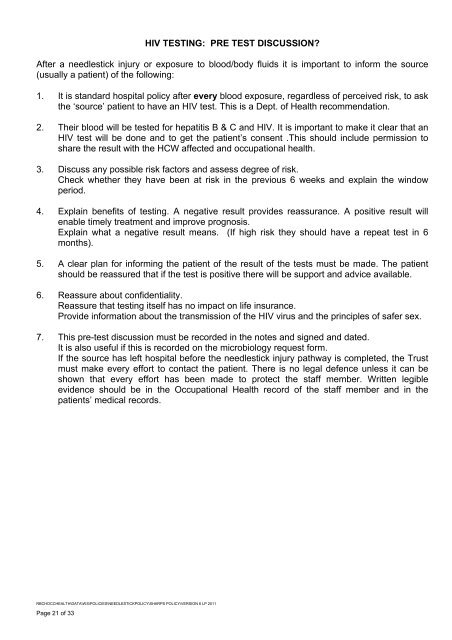Management of Needlestick & Contamination Injuries - Royal ...
Management of Needlestick & Contamination Injuries - Royal ... Management of Needlestick & Contamination Injuries - Royal ...
Surname: Forename: DoB:For what purpose was the sharp item originally used?Did an injury occur?Which device caused the injury?Where was the injury?If the injury was to the hand, did the sharp penetrate?Management of Incident discussed with:Blood taken from staff member for Hepatitis B antibodies and storage(Use Red Top bottle)Date:Treatment required/given:Hepatitis B InoculationHepatitis C ImmunoglobulinHIV Post exposure prophylaxisType of follow up required:Assessment completed by (signed) ....................................................................Date:Blood taken from Donor Source date:Name:Job title:Appendix BRBCHOCCHEALTH\DATA\WS\POLICIES\NEEDLESTICKPOLICY\SHARPS POLICY\VERSION 6 LP 2011Page 20 of 33
HIV TESTING: PRE TEST DISCUSSION?After a needlestick injury or exposure to blood/body fluids it is important to inform the source(usually a patient) of the following:1. It is standard hospital policy after every blood exposure, regardless of perceived risk, to askthe ‘source’ patient to have an HIV test. This is a Dept. of Health recommendation.2. Their blood will be tested for hepatitis B & C and HIV. It is important to make it clear that anHIV test will be done and to get the patient’s consent .This should include permission toshare the result with the HCW affected and occupational health.3. Discuss any possible risk factors and assess degree of risk.Check whether they have been at risk in the previous 6 weeks and explain the windowperiod.4. Explain benefits of testing. A negative result provides reassurance. A positive result willenable timely treatment and improve prognosis.Explain what a negative result means. (If high risk they should have a repeat test in 6months).5. A clear plan for informing the patient of the result of the tests must be made. The patientshould be reassured that if the test is positive there will be support and advice available.6. Reassure about confidentiality.Reassure that testing itself has no impact on life insurance.Provide information about the transmission of the HIV virus and the principles of safer sex.7. This pre-test discussion must be recorded in the notes and signed and dated.It is also useful if this is recorded on the microbiology request form.If the source has left hospital before the needlestick injury pathway is completed, the Trustmust make every effort to contact the patient. There is no legal defence unless it can beshown that every effort has been made to protect the staff member. Written legibleevidence should be in the Occupational Health record of the staff member and in thepatients’ medical records.RBCHOCCHEALTH\DATA\WS\POLICIES\NEEDLESTICKPOLICY\SHARPS POLICY\VERSION 6 LP 2011Page 21 of 33
- Page 1 and 2: Management of Needlestick& Contamin
- Page 3 and 4: CONTENTS:SectionsPage Nos1.0 Flow c
- Page 5 and 6: 2.0 POLICY STATEMENTRoyal Bournemou
- Page 7 and 8: 4.2 Sharp Injury Prevention and Man
- Page 9 and 10: • All sharps boxes must be sited
- Page 11 and 12: must include: assurance of confiden
- Page 13 and 14: 7.3.3 Exposed person vaccinated but
- Page 15 and 16: Unconscious patients, or those with
- Page 17 and 18: CRITERIA HOW WHERE WHEN LEADReview
- Page 19: Appendix ANeedlestick/Sharps Incide
- Page 23 and 24: Appendix DMANAGEMENT OF HIGH RISK E
- Page 25 and 26: Appendix F7.0 ADVICE AND SUPPORT FO
- Page 27 and 28: 6. Minutes of Meetings6.1 The Secre
- Page 29 and 30: 10. AuthorityThe Committee is autho
- Page 31 and 32: Regular Reports Provided to Health
- Page 33: 7. Does this document affect anindi
HIV TESTING: PRE TEST DISCUSSION?After a needlestick injury or exposure to blood/body fluids it is important to inform the source(usually a patient) <strong>of</strong> the following:1. It is standard hospital policy after every blood exposure, regardless <strong>of</strong> perceived risk, to askthe ‘source’ patient to have an HIV test. This is a Dept. <strong>of</strong> Health recommendation.2. Their blood will be tested for hepatitis B & C and HIV. It is important to make it clear that anHIV test will be done and to get the patient’s consent .This should include permission toshare the result with the HCW affected and occupational health.3. Discuss any possible risk factors and assess degree <strong>of</strong> risk.Check whether they have been at risk in the previous 6 weeks and explain the windowperiod.4. Explain benefits <strong>of</strong> testing. A negative result provides reassurance. A positive result willenable timely treatment and improve prognosis.Explain what a negative result means. (If high risk they should have a repeat test in 6months).5. A clear plan for informing the patient <strong>of</strong> the result <strong>of</strong> the tests must be made. The patientshould be reassured that if the test is positive there will be support and advice available.6. Reassure about confidentiality.Reassure that testing itself has no impact on life insurance.Provide information about the transmission <strong>of</strong> the HIV virus and the principles <strong>of</strong> safer sex.7. This pre-test discussion must be recorded in the notes and signed and dated.It is also useful if this is recorded on the microbiology request form.If the source has left hospital before the needlestick injury pathway is completed, the Trustmust make every effort to contact the patient. There is no legal defence unless it can beshown that every effort has been made to protect the staff member. Written legibleevidence should be in the Occupational Health record <strong>of</strong> the staff member and in thepatients’ medical records.RBCHOCCHEALTH\DATA\WS\POLICIES\NEEDLESTICKPOLICY\SHARPS POLICY\VERSION 6 LP 2011Page 21 <strong>of</strong> 33



